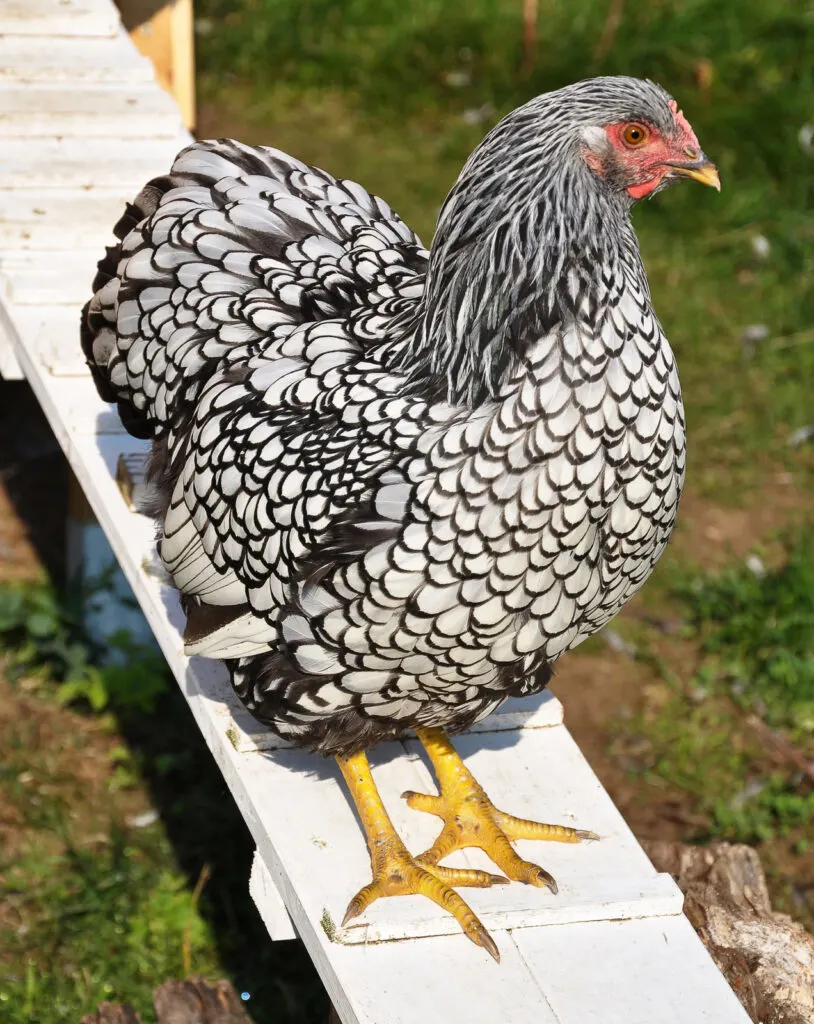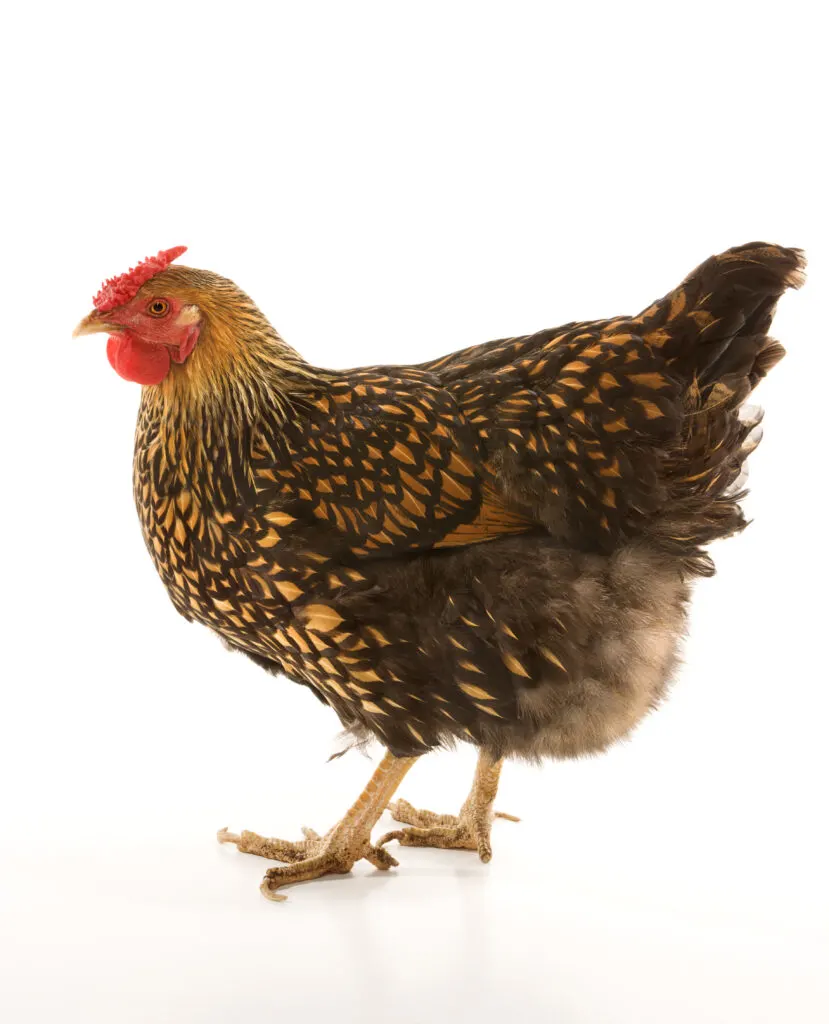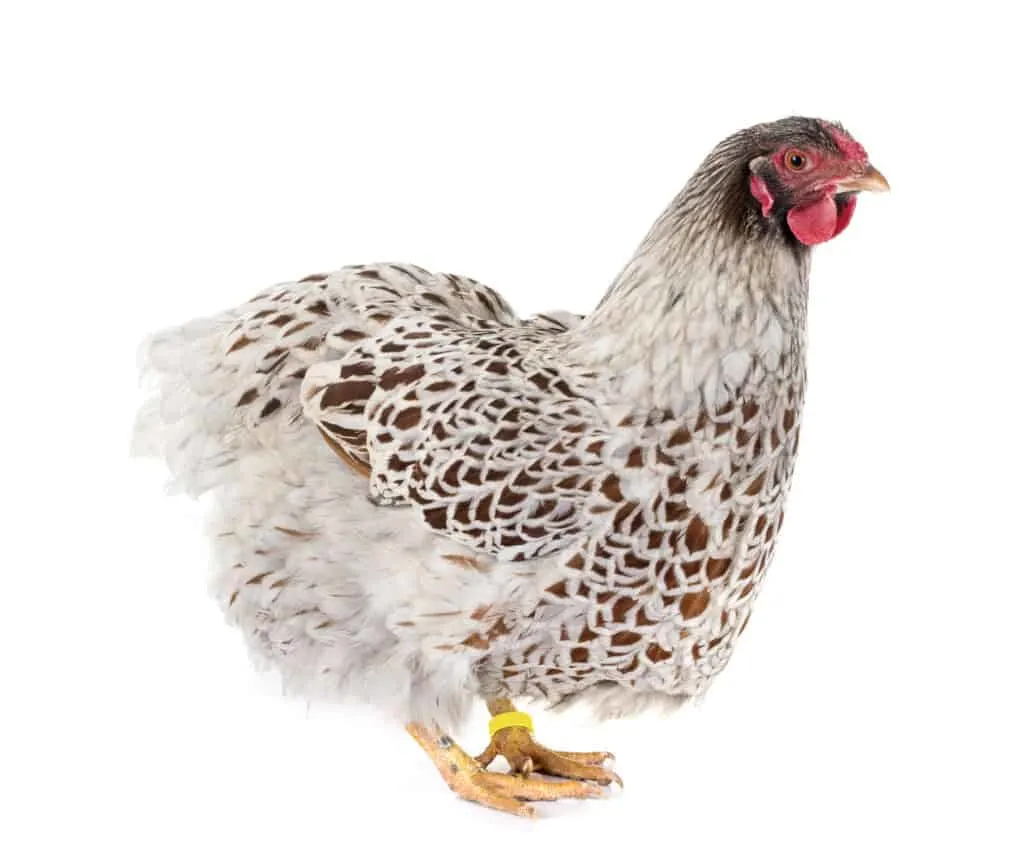If you are looking to grow your flock or just starting, it is essential to know which chicken breed is right for you and your farm.
Wyandotte Chickens are a hearty, docile breed that is beginner-friendly. They are medium, dual-purpose birds that produce eggs generously and grow large enough to be a good meat source. This, in combination with their beautiful colors, makes them an excellent addition to any flock.
Is the Wyandotte right for your flock?
- Wyandottes are available in 10 different gorgeous color varieties
- They are calm, gentle birds that are great with beginners and kids
- Wyandottes are suitable for hot and cold environments
- They are good producers of large cream or brown eggs
For beginning backyard chicken keepers, choosing the right breed of chicken is critical to first-time success. This article discusses the temperament, traits, and production of Wyandotte Chickens. Read on to see if they will be a good fit for your farm family.
Table of Contents
Background & History of the Breed
The Wyandotte chicken breed originated in northern New York and southern parts of Canada. Initially, the breed was referred to as the American Sebright but was renamed to Wyandotte to honor a Native American tribe from the region.
This breed became popular after its debut at the Chicago World Fair. They are known for their remarkable color variations, with the silver and gold-laced patterns being the most popular. At the fair, Americans saw the Columbian Wyandotte for the very first time.
According to James Wallace, author of Wyandottes: Silver, Golden, Black, and White, the Wyandotte is a descendant of the Brahma breed. Brahma chickens are popular choices for beginner chicken keepers but are not as hardy in harsh temperatures as the Wyandotte.

The Wyandotte has a different comb than the Brahma, yet the breeds share several color variations. They are of similar shape and weight, and both have clean legs. The Brahma has a pea comb, while the Wyandotte has a rose comb.
Wyandotte breeding began in the mid-1800s as chicken keepers sought a docile breed with rose combs to keep outdoors in the winter. By crossing Brahma’s with several popular breeds, they obtained a new breed, the American Sebright, which was renamed to the Wyandotte in 1883.
In 2016, Wyandotte chickens graduated from the endangered list of The Livestock Conservancy. The organization does ask that any Wyandotte chicken with a full comb not be used as breeding stock. This lessens the hardiness of the breed and is likely to reduce their numbers.
It is important to note that there is a separate breed of chicken known as the Bantam Seabright. These are smaller birds and differ from the Wyandotte chickens, despite once sharing a similar name.

Temperament & Behavior
These beautiful birds are incredibly docile. They are perfect for a farm with kids and the beginner chicken keeper. With their beautiful plumage and generous egg cycle, Wyandotte chickens are a rewarding introduction to chicken care.
At times, the Wyandotte can become broody, but this is rare. Typically, these chickens have calm and gentle personalities that are easy to work with. Their gentle nature makes them safe for children to be around, and egg collection is a breeze.
Should a Wyandotte hen become broody, or determined to hatch its unfertilized eggs, they are often easy to break through gentle coaxing. Simply remove them from the nest and close off their access to the nesting box.
Wyandotte chickens are decent foragers but should not be left to survive on their foraging abilities alone. They will need a well-balanced commercial feed to help support their hefty egg-laying.

Breed Specifics & Traits
The Wyandotte chicken is a dual-purpose bird. This means they are a smart choice for people wanting a hen to lay eggs or a chicken to raise for meat. If you choose to incubate eggs, you can use the hens as layers and the roosters for meat and breeding stock.
The mature size of the bird depends on their sex. Female birds are smaller, weighing 6 ½ pounds, on average. Roosters can grow much larger, weighing an average of 8 ½ pounds. Wyandottes are considered to be a medium breed of chicken.
Wyandotte chickens that are properly cared for can live for six years. This is about average for a medium chicken breed. After three years, you will see a decline in egg production. However, your senior chickens still have many uses on your farm!
Chickens who don’t lay eggs can still help with pest control by foraging for the larvae of pesky insects such as flies and mosquitos. Their waste is an excellent fertilizer for any garden beds you are tending.
The appearance of the Wyandotte varies across its ten recognized color variations. The chick always has a combination of the colors expected in the feather pattern when the bird reaches maturity.
- Silver Laced: The silver laced wyandotte has silver feathers with a black rim. A silver laced wyandotte chick will have a combination of silver and black down feathers.
- Gold Laced: The gold-laced Wyandotte has gold feathers with black rims. A gold-laced Wyandotte chick will have a combination of these two colors or be solid one or the other,
- Columbian: Columbian Wyandottes have a beautiful black and white pattern throughout their feathers. These chickens are the poultry cousins to 101 Dalmatians! Chicks will either be white, black, or a speckled combination of both.
- Blue-Laced Red: Like the two other laced variations above, the blue laced red Wyandotte has blue feathers with red rims. They also come in a splash variety. Chicks will be blue, black, or a combination of both.
- Silver Laced: Silver laced Wyandottes, also called Black Laced Silver Wyandotte, has silver feathers with black rims. Their chicks are black and grey patterned.
- White: Just your standard white chicken with a red comb. The white Wyandotte starts as a yellow chick before growing in mature white feathers.
- Buff: Buff is a dark grey shade with a subtle hint of blue. These chickens start much lighter as chicks before adopting their beautiful buff hue as adults.
- Blue: Blue chicks are anywhere from a light blue to a near black. As they grow, their mature feathers have a startling blue hue that will stand out in any flock.
- Black: A black chicken is black from birth. The chicks are black, and their mature feathers come in black as well.
- Silver Penciled: This is a very intricate color variation of thin dark streaks across a “silver” backdrop. Chicks are yellow with small black speckles.
You can view images of both one-day-old and mature chickens in each of these variations on the Meyer Hatchery website.
All of these color variations have a few traits in common. Wyandotte chickens have clean, yellow legs and four toes. They have a red rose comb and rounded bodies. With all this variation, the Wyandotte can be found at most poultry shows.
Wyandottes have a below-average noise level when compared to other chicken breeds. They are less likely to disturb your neighbors if you live in a more populated area. Wyandottes are poor fliers, leaving them susceptible to predators on the ground and in the air.
This breed of chicken is incredibly hardy in all kinds of extreme weather. They can withstand the heat and also can survive through cold winters. It is common for the hens to lay fewer eggs during extreme weather seasons.
Since the Wyandotte breed is a cross of several breeds, they have not developed any genetic diseases yet. They are still susceptible to flock parasites and nutrient deficiencies, but proper care and maintenance will prevent that.

Eggs
Wyandotte chickens reach maturity at 20 weeks of age. This is when the hens will begin laying eggs, and the roosters are at an acceptable weight to butcher. Because these birds are dual-purpose, you get both meat and eggs from Wyandotte chickens.
The eggs are large and cream to brown in color. Wyandottes make a uniform dozen, with each egg being similar in shade, shape, and size. Some eggs may have a few dark speckles, but overall the eggs look very similar.
On average, each hen will lay approximately 4-6 eggs each week. That is over 300 eggs a year! That is why this breed is suitable for small farms that need each member to be a strong contributor. You are almost guaranteed an excellent laying year from each mature hen.
Where to buy
You can get Wyandotte chickens from most online hatcheries. A day-old chick typically costs anywhere from four to five dollars, with a few more expensive color variations. They are usually sold in a minimum grouping of six chicks to ensure safe shipment.
You can find Wyandotte chickens for sale at Cackle Hatchery. Cackle offers 7 different wyandotte varieties, with chicks, hatching eggs, pullets, and bantam birds available. They even have show quality birds. Wyandottes start at $2 each, and they have a 3 chick minimum (most hatcheries have a 15 chick minimum order).
Cackle Hatchery is our preferred and recommended hatchery. While most hatcheries require orders of at least 25 chicks, you can buy as few as 3 chicks from Cackle. They are also highly rated on Google and have been in business since 1936.
Summary
In summary, the Wyandotte chicken is a great beginner bird. Their gentle and calm personalities make them easy to work with. Generous egg production and meat provision allow the bird to be a useful member of any farm.
With their ten color variations, these birds are incredibly aesthetic. Wyandottes are a common breed choice for individuals wanting to enter their chickens into poultry shows. This hardy breed adapts well to harsh climates.
| Type | Dual Purpose |
| Size | Medium |
| Heritage Breed | Yes |
| Average Weight | Roosters: 8 ½ lbs, Hens: 6 ½ lbs |
| Weeks To Maturity | 16-20 weeks |
| Average Life Span | 6 years |
| Color variations | Silver Laced, Gold Laced, Columbian, Blue Laced Red, White, Buff, Blue, Black, SIlver Penciled |
| Egg Size | Large |
| Egg Color | Cream to Brown |
| Egg Production | 4-6 per week |
| Dual Purpose | Yes |
| Temperament | Calm/Gentle |
| Beginner Friendly | Yes |
| Kid Friendly | Yes |
| Heat Tolerant | Yes |
| Cold Tolerant | Yes |
| Comb Type | Rose |
| Broodiness | Occasional |
| Flightiness | Poor Fliers |
| Noise Level | Below average |
| Unique Traits | Yellow skin, clean legs, rounded bodies |

jalynn
Monday 27th of February 2023
What are by products of the wyandotte